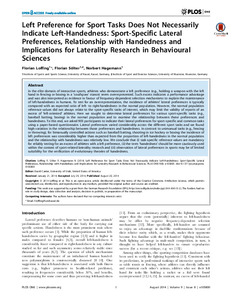| dc.date.accessioned | 2014-10-30T13:03:50Z | |
| dc.date.available | 2014-10-30T13:03:50Z | |
| dc.date.issued | 2014 | |
| dc.identifier.issn | 1932-6203 | |
| dc.identifier.uri | urn:nbn:de:hebis:34-2014103046210 | |
| dc.identifier.uri | http://hdl.handle.net/123456789/2014103046210 | |
| dc.description.sponsorship | Gefördert durch den Publikationsfonds der Universität Kassel | |
| dc.language.iso | eng | |
| dc.rights | Urheberrechtlich geschützt | |
| dc.rights.uri | https://rightsstatements.org/page/InC/1.0/ | |
| dc.subject.ddc | 796 | |
| dc.title | Left preference for sport tasks does not necessarily indicate left-handedness | eng |
| dc.type | Aufsatz | |
| dcterms.abstract | In the elite domain of interactive sports, athletes who demonstrate a left preference (e.g., holding a weapon with the left hand in fencing or boxing in a ‘southpaw’ stance) seem overrepresented. Such excess indicates a performance advantage and was also interpreted as evidence in favour of frequency-dependent selection mechanisms to explain the maintenance of left-handedness in humans. To test for an overrepresentation, the incidence of athletes’ lateral preferences is typically compared with an expected ratio of left- to right-handedness in the normal population. However, the normal population reference values did not always relate to the sport-specific tasks of interest, which may limit the validity of reports of an excess of ‘left-oriented’ athletes. Here we sought to determine lateral preferences for various sport-specific tasks (e.g., baseball batting, boxing) in the normal population and to examine the relationship between these preferences and handedness. To this end, we asked 903 participants to indicate their lateral preferences for sport-specific and common tasks using a paper-based questionnaire. Lateral preferences varied considerably across the different sport tasks and we found high variation in the relationship between those preferences and handedness. In contrast to unimanual tasks (e.g., fencing or throwing), for bimanually controlled actions such as baseball batting, shooting in ice hockey or boxing the incidence of left preferences was considerably higher than expected from the proportion of left-handedness in the normal population and the relationship with handedness was relatively low. We conclude that (i) task-specific reference values are mandatory for reliably testing for an excess of athletes with a left preference, (ii) the term ‘handedness’ should be more cautiously used within the context of sport-related laterality research and (iii) observation of lateral preferences in sports may be of limited suitability for the verification of evolutionary theories of handedness. | eng |
| dcterms.accessRights | open access | |
| dcterms.alternative | Sport-specific lateral preferences, relationship with handedness and implications for laterality research in behavioural sciences | eng |
| dcterms.bibliographicCitation | In: PLoS one. - Lawrence, Kan. : PLoS, 2014, Vol. 9, Issue 8, e105800, 1-8 | |
| dcterms.creator | Loffing, Florian | |
| dcterms.creator | Sölter, Florian | |
| dcterms.creator | Hagemann, Norbert | |
| dc.relation.doi | doi:10.1371/journal.pone.0105800 | |
| dcterms.source.issue | 8 | |
| dcterms.source.journal | PLoS one | |
| dcterms.source.pageinfo | S. 1-8 | |
| dcterms.source.volume | 9 | |

